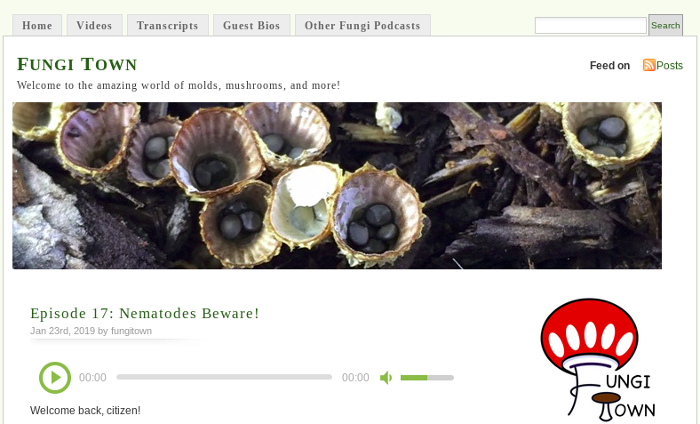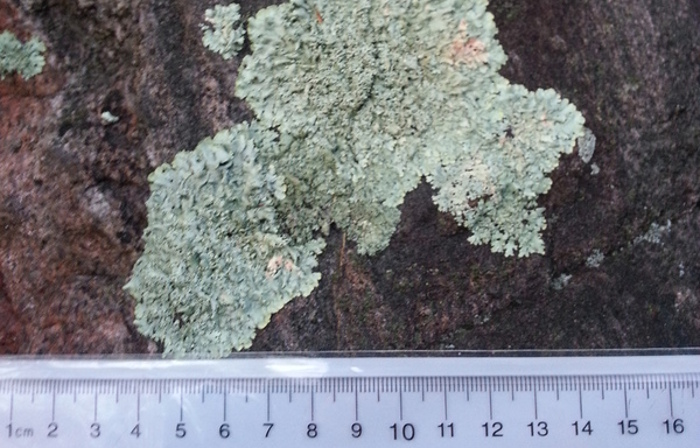Another podcast I support and recommend is Fungi Town, which is all about fungi. They’re not plants, they’re not animals, but they’re closer to animals than to plants. They’re really interesting.
The host is Jen Parrilli, the mayor of Fungi Town (say it with a hard G, like “Funky Town”). Every episode she interviews one or two experts and they talk about something related to fungi. Parrilli really knows her stuff so the talks get detailed, but they’re always accessible. She has a regular “Defunked” feature where she debunks a fungi-related myth or misunderstanding. The episodes are a half hour or so, and come out about every couple of weeks, so it’s easy to keep up.

The current episode, Nematodes Beware! is a talk with Greg Thorn at the University of Western Ontario (“Western,” as everyone in Canada calls it). It’s a good episode to try to see if you might like the show. Thorn tells about nematodes (tiny little wormy things; C. elegans is a nematode and is used by scientists for all sorts of research) and how fungi eat nematodes! Check this out:
JP: Tell me more about nematophagous fungi. They actually trap and eat nematodes, right?
GT: Right, so some of them trap them. And you might call them predators in that sense, because one mycelium of the fungus - all the network of fine, microscopic threads in the soil or rotting wood, wherever it’s growing - produce actual traps. So that when a nematode passes through the trap or over the trap if it’s a sticky one, the nematode is caught and then gradually penetrated and digested. And then its nutrients are passed through the mycelial network to allow that network to continue growing and perhaps reproducing. So one mycelium can trap many many, thousands even, of nematodes. So it’s very much like a predator. Other nematode-eating fungi, or nematophagous fungi catch one nematode at a time. And they do this by either sticking to them, using an adhesive spore, or getting swallowed by the nematode, or some other mechanisms which are really very fancy. But one way or the other one nematode swims away and then is colonized from inside … They eat the whole nematode, and so instead of laying eggs or more baby nematodes the nematode body is entirely taken up by the fungus, and it grows out and produces more spores, which go off and catch more nematodes.
Specialized fungi colonizing the insides of nematodes and then bursting out! And later there’s this about oyster mushrooms:
GT: Yeah, so Pleurotus ostreatus is the common oyster mushroom that people may know from the grocery store, and it turns out that it’s a very active nematode-eater. And its story is a little different. Of course it’s a mushroom, not an ascomycete. And it’s a very, very good wood rotter, and because it was an edible mushroom it’s been known for centuries. But this part of its life cycle, that it eats nematodes, wasn’t known until the 1980s. So that was kind of one of the fun things that we discovered when I was working with George Barron, that if you grow it in a Petri dish culture with no extra nutrients, so we just grow them on water agar, and then after it’s grown out a while you add some nematodes. Lo and behold it produces these little toxin droplets that immobilize the nematodes. The nematode bumps into the toxin droplets and after a while it stops swimming. And then the hyphae of the Pleurotus actually grow towards the mouth of the nematode, while it’s still living, and down its throat, and then digests it from the inside out.
This mushroom paralyzes a nematode and then sends a tendril down its mouth to eat it from the inside out! And if you’re near a big grocery store you could probably go buy that mushroom tomorrow and eat it yourself. That’s showing fungus who’s boss! Just watch out they don’t retaliate with athlete’s foot or a yeast infection or something fatal.
Aside from mushrooms and yeast, my favourite fungi are the ones that team up with algae or cyanobacteria to make lichen. Episode 4, Lichen or Not, is all about lichen.

 Miskatonic University Press
Miskatonic University Press